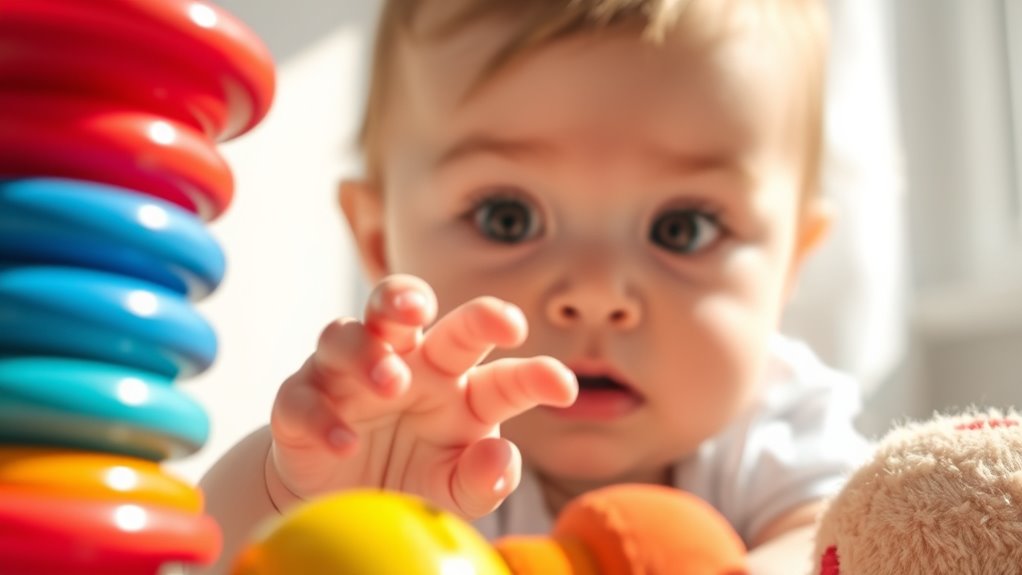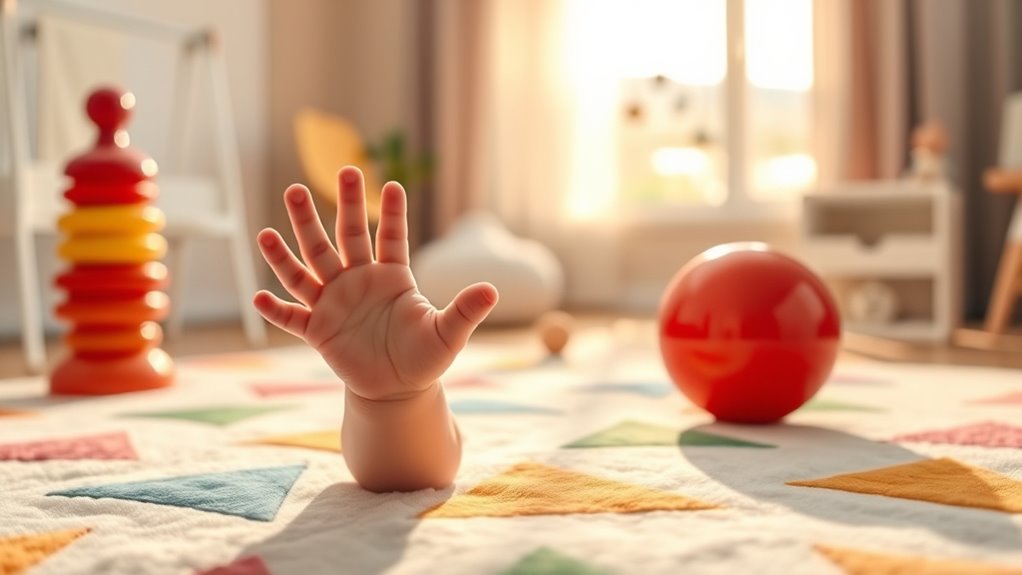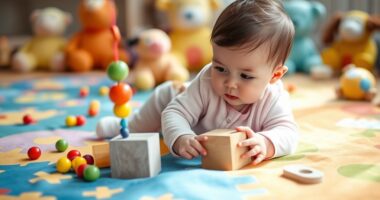To boost your baby’s hand-eye coordination, try engaging games like “Feed the Baby,” where they toss objects into a box, or a DIY ring toss for aiming practice. Outdoor activities like ball tossing and frisbee help improve catching skills. Think about threading chunky beads or using lacing cards for fine motor development too. These fun activities not only enhance coordination but also foster bonding. There’s so much more to explore to support your baby’s growth and skills!
Key Takeaways
- Engage in “Feed the Baby Game” using a cardboard box to enhance aiming and precision skills.
- Create a DIY ring toss with paper plates and sticks for fun coordination practice.
- Play “Cup Rolling” by rolling a ball into taped cups to promote engagement and motor skills.
- Use threading chunky beads or lacing cards to strengthen fine motor skills and hand-eye coordination.
- Organize outdoor ball tosses or Frisbee games to improve catching and throwing abilities.

As your baby grows, you’ll notice their hand-eye coordination developing, which is crucial for everyday tasks and overall development. This skill starts forming around three months old and continues to evolve throughout childhood. It’s the synchronization of visual input with motor responses, vital for activities like writing, drawing, and even using digital devices. Encouraging this coordination can significantly impact your baby’s academic performance and social interactions.
Hand-eye coordination begins developing around three months and is essential for your baby’s growth and future success.
You can create fun opportunities for your baby to enhance their hand-eye coordination through indoor games. One enjoyable activity is the “Feed the Baby Game,” where you can use a cardboard box with a hole for the mouth, allowing your baby to practice placing objects inside. Another simple yet effective game is DIY ring toss using paper plates and sticks, which helps with aiming and precision. For a sensory exploration, try “Push and Pull Straws” by cutting holes in a cereal box and letting your baby experiment with straws.
“Cup Rolling” is another engaging option; tape cups to a surface and roll a ball into them. Don’t forget classic nursery rhymes like “Pat-a-Cake,” which promote coordination through clapping and rhythm.
When it comes to outdoor activities, ball tosses are perfect for practicing catching and throwing. You can enhance this experience with a Frisbee, as tossing it back and forth improves tracking and catching skills. An adjustable basketball hoop can also be a fantastic tool for developing your baby’s coordination, whether played indoors or outdoors. For a more dynamic experience, consider “Ultimate Frisbee,” which adds intensity and teaches quick reactions.
Fine motor activities are equally important. Activities like threading chunky beads or using lacing cards can enhance fine motor skills while being enjoyable. Pounding toys with a wooden mallet can strengthen their grip and coordination. Pipe cleaner activities, where your baby threads beads onto pipe cleaners, can also provide stability and fun.
Engaging in sports like table tennis or tennis can further enhance hand-eye coordination. These sports improve reflexes, concentration, and timing. Baseball and softball also develop muscle memory and quick reactions, essential for everyday tasks.
All these activities not only boost hand-eye coordination but also contribute to your baby’s overall cognitive, physical, and emotional development. By participating together, you can cultivate a bonding experience that enhances their confidence and self-esteem through achievements.
Frequently Asked Questions
What Age Should Babies Start Developing Hand-Eye Coordination?
Babies start developing hand-eye coordination as early as 2-3 months, when they begin tracking moving objects and discovering their hands.
By 4-6 months, you’ll notice them reaching for and grasping items, even if they sometimes miss.
As they approach 6 months, their coordination improves significantly, allowing them to explore more effectively.
How Can I Tell if My Baby Has Good Hand-Eye Coordination?
Imagine your baby as a little artist, painting the world with their hands. You can tell if your baby has good hand-eye coordination by observing their ability to track moving objects, reach for toys, and grab them with precision.
If they can transfer objects from one hand to the other or throw a ball with some accuracy, you’re witnessing their developing skills.
Look for milestones like the pincer grasp to gauge progress, too!
Are There Specific Toys That Promote Hand-Eye Coordination?
Yes, there are specific toys that promote hand-eye coordination!
Building blocks and stackable rings are great for grasping and balancing. Puzzles and shape sorters challenge your child to match shapes, enhancing their coordination.
Lacing beads and cards improve fine motor skills as they thread and lace. Active games like ring toss and mini bowling require aiming and rolling, further developing their skills.
Choose a variety of these toys to support your child’s growth!
How Often Should We Play These Games With Our Baby?
You’ve got a busy life, but who needs sleep when you can engage in daily play?
Just 5-10 minutes a day keeps your little one thriving!
Think of it as a mini workout—short bursts of fun, minus the sweat.
Switch up the games to keep things lively; boredom isn’t your baby’s friend.
Supervise like a hawk, and watch those skills blossom!
Can Screen Time Negatively Affect Hand-Eye Coordination Development?
Yes, screen time can negatively affect hand-eye coordination development.
When you let your child spend too much time in front of screens, they miss out on essential physical play that builds coordination skills. Limited movement and visual tracking from fast-moving images hinder their ability to develop fine motor skills.
Balancing screen time with active play is crucial for promoting healthy growth and ensuring your child has the coordination skills they need for everyday activities.
Conclusion
Playing games that boost your baby’s hand-eye coordination can turn every moment into a delightful adventure. As you engage in these playful activities, you’re not just having fun; you’re laying the foundation for their future skills. Remember, each little game is like planting a seed that’ll grow into a mighty oak of coordination! So, keep exploring, laughing, and playing together, because these precious moments will create memories that last a lifetime—and beyond!









